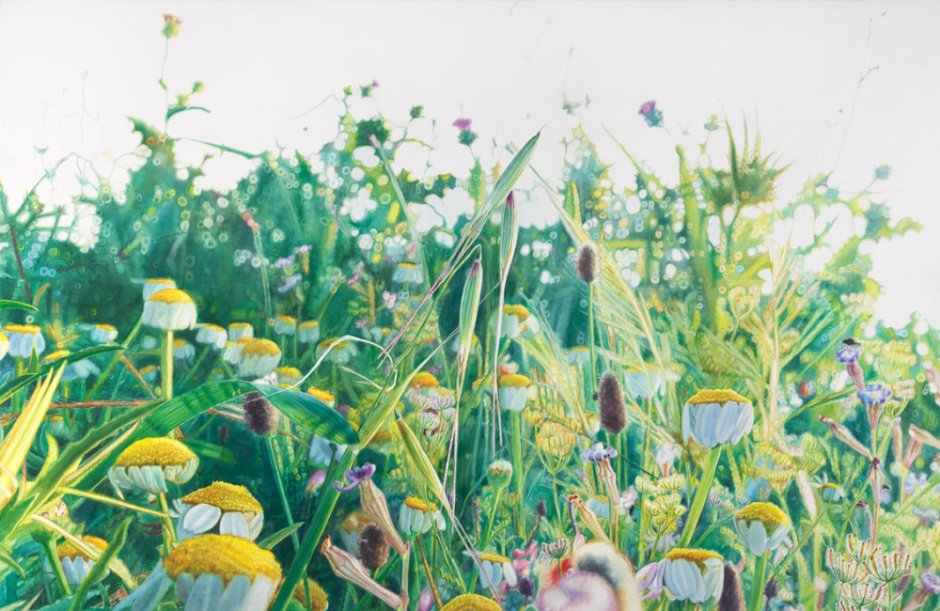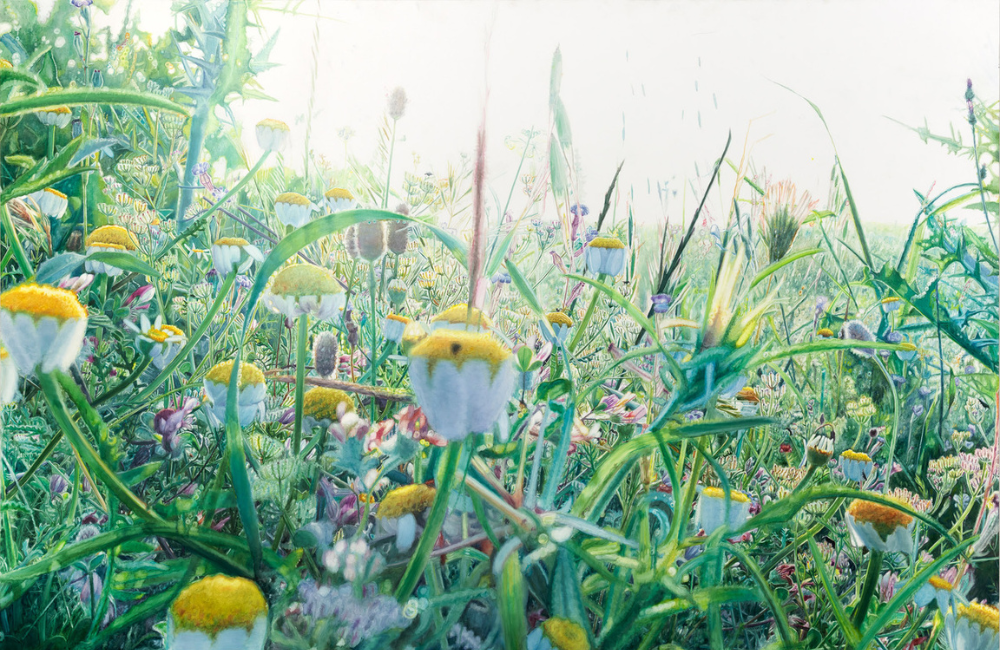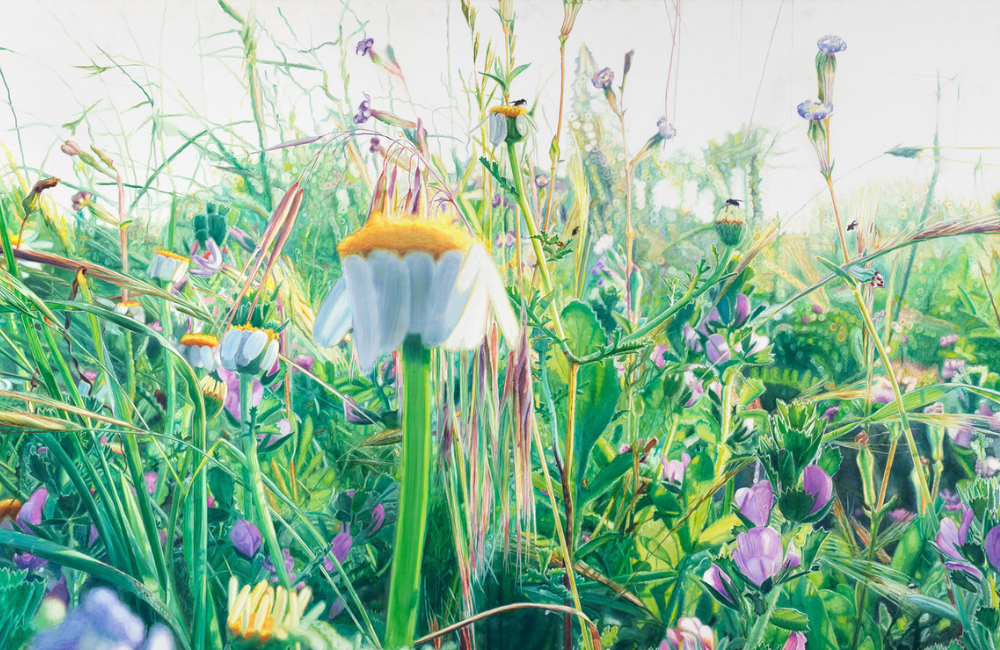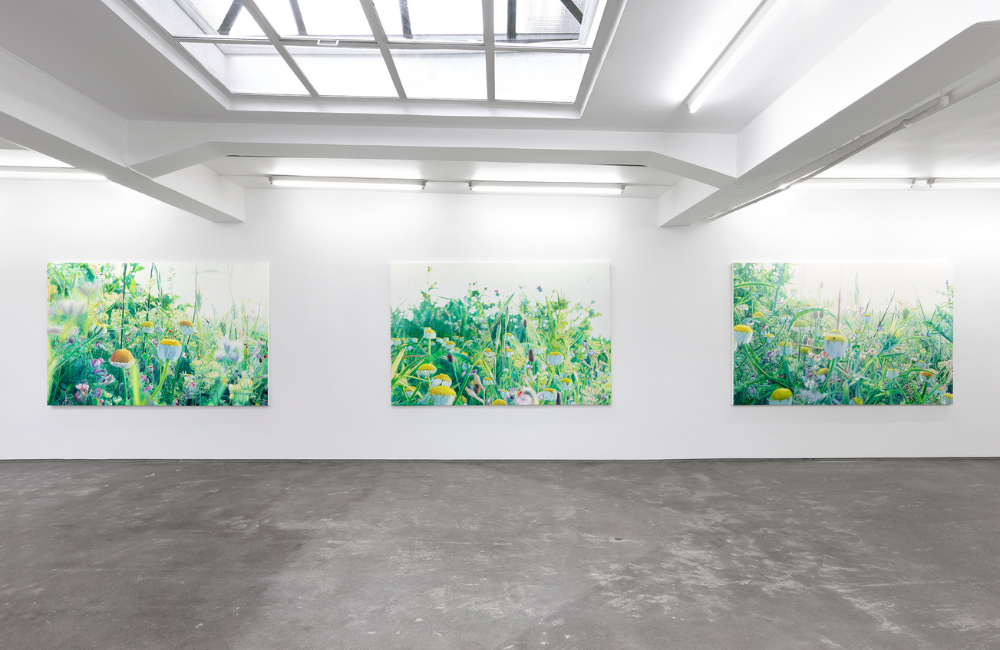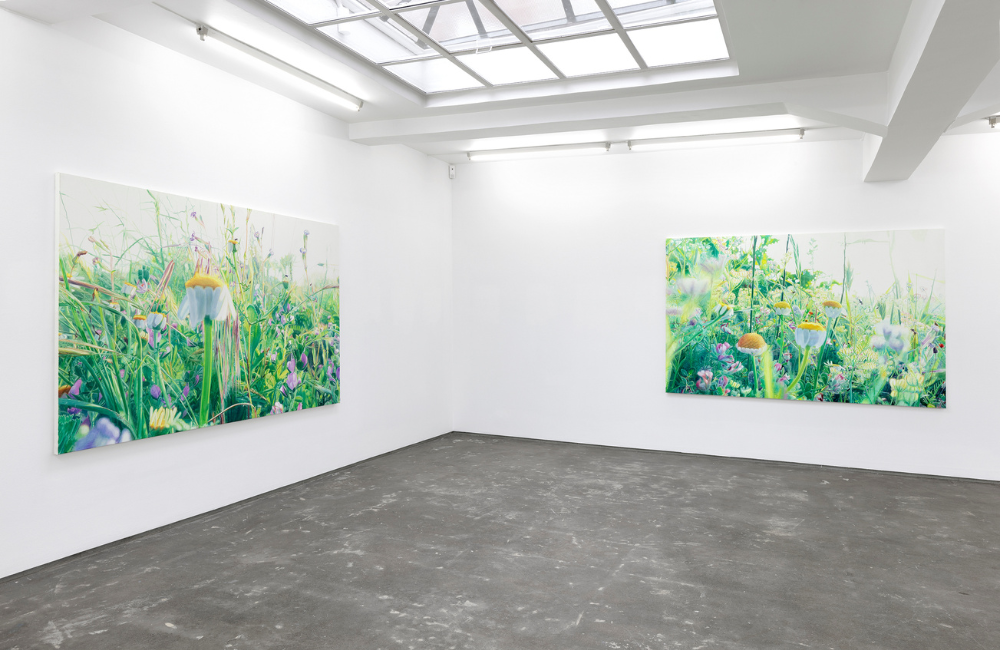VIBEKE SLYNGSTAD AND THE SHUAFAT PAINTINGS: A NEW ARTISTIC VISION AT OSL GALLERY
Vibeke Slyngstad: The Shuafat Paintings.
This spring, Norwegian artist Vibeke Slyngstad presents her latest solo exhibition with OSL Gallery in Oslo, comprising six new paintings from the ongoing Shuafat series, started in 2019. London-based editor and writer Matt Price spoke with the artist ahead of the exhibition’s opening.
MP So, Vibeke, you started the works for your upcoming exhibition with OSL Gallery in the summer of 2023?
VS Yes. I had an exhibition in London at the end of June with Kristin Hjellegjerde Gallery, so after that I took a holiday and then started work on this project with OSL. I’m really looking forward to it. The space at OSL is very nice. In a way it’ll be more like an installation because it’ll all be in one room – it’s a room where it feels very natural to do more of an installation with the paintings.
MP Can you tell me about this new series of work? Obviously it builds on from earlier landscape series that you’ve worked on.
VS I started this series with very small paintings, about 50 by 70 centimetres. 2019 was when I first exhibited these landscape paintings.
MP And this was with the Citadel works?
VS Yes, it was Citadel and also Shuafat and Sønstegård. They were all the same height, so in a way it was like a slide show with different landscapes. I was a little anxious about showing these landscape works because for many years I mostly painted architectural themes and motifs, but before, in the nineties, I worked a lot with landscape, and I came to a period where I wanted to go back to it and see if there were possibilities to do it in a new, contemporary way. But in Norway it’s perhaps not so easy to be a contemporary artist with landscape painting; it’s seen as a bit old fashioned. So I took my time. For me it was like an act of resistance starting with landscape painting. I come from the west coast; I spent my childhood there. The landscape on the west coast is very grandiose, with big mountains and so on, and I wanted to have the viewpoint of a child sitting on the ground as I did when I was a child playing by the shore. I wanted to have a different angle. I was very nervous for the first show, but it went very well, I got a good response. So now I wanted to make a larger series, and these are the biggest paintings I’ve done. I hadn’t actually exhibited in Norway since that show in 2019, just abroad a lot. For me the location is very important; I have this personal attachment to the location. These paintings are from Shuafat in East Jerusalem. I visited some friends who live there; she was a Norwegian diplomat to Palestine and they lived in that area. Most people, when you say Shuafat, think about the refugee camp, but it’s also a residential area. It was very nice actually, peaceful, but just outside the building was this huge area where it was just wild weeds, like in no man’s land. Of course somebody owns it, but it’s been an area where the Palestinians wanted to build but Israel has said no. I was in that field and I started photographing. I had many feelings; it was a very beautiful area. My exhibition is titled Wild Weeds, and for me it was also a question of definition: if they are in nature they are not unwanted. So a lot of different emotions come up when I make these paintings, especially now with the conflict.
MP Would you say that you are a political artist?
VS I would say that in some ways I am a political artist; I feel like I want to express something in my paintings, so it matters to me what kind of image I make. I think there are so many different levels to painting. I would say that my prime driving force is to explore the possibilities in contemporary figurative painting; it has to function as a painting and politics is inevitably interwoven in that.
MP It must feel quite different to be painting somewhere far away after you’ve been painting locations that have very personal, family connections. Could you tell me about that experience of landscape and growing up? Were you surrounded by nature as a child, were you always out in nature?
VS Yes; we moved from the centre of Ålesund to somewhere just ten minutes outside. I lived by the shore, and I spent a lot of time alone in nature. I felt a real happiness and creative joy in nature. Growing older, you start thinking back, and over the last few years I think I picked this motivation I had as a child up in the paintings.
MP Are you an only child?
VS No; I have a brother and a sister, but I’m the youngest.
MP So you were often out in the landscape playing with them but also sometimes by yourself?
VS Yes. And my mother was very good with taking me out. She’s from Austria and she’s very into nature. We picked a lot of mushrooms, every time we found an insect we bent down to look at it, she’s very into every plant, every animal. I remember we went to the Austrian Alps a lot, where there are all these different habitats, so many levels – five hundred metres, then a thousand metres and so on – and it’s so different; there were wild orchids. So it was an important part of my youth, both in Norway and in Austria, walking in nature.
MP Are you conversant yourself with the names of all the different species? The plants and the flowers, the succulents, the grasses?
VS Many of them, but not all!
MP For example in your paintings from Sønstegård and Brusand there will be very particular local flora, and people from Norway would perhaps recognise that as being from home?
VS Yes; Sønstegård is about an hour from Oslo, so it’s one of the first areas by the ocean you can reach from there. I like it very much by the ocean; there are these special plants. They’re tiny but also very hardy, perfect for the bad weather, so they have a kind of contradiction in them. Brusand is on the west coast, and many people would recognise it. It’s maybe like Scotland, with its hills and the wind.
MP You are very engaged with the detail, the close-up, and yet there is obviously a lot of landscape around that you are choosing to filter out. What is it about the detail that’s especially appealing to you at the moment?
VS I think I want it to be grounded, and to have this perspective as a child would see it. I love sitting on the ground, and I think that details are in a way the whole world, like fractals where you zoom in and it’s the same structure. So it’s like the whole world in microcosm when I zoom in to all this small detail. It surrounds you this way, rather than when you’re standing looking into the distance, and it’s like a world inside you. It’s that more hermetic world that interests me, as if there’s nothing outside it. I want it to be more like a condition, a state of mind, staying in these landscapes.
MP The paintings capture some of the first memories, or experiences, of landscape and nature many of us have, where you can only see the things that are immediately around you. And the fascination you have as an older child, looking at those insects and at all the plants and flowers, these are the views that you have at such moments growing up. Every morning I walk through a graveyard on my way to the park, so your paintings make me think about the whole life cycle – your paintings could also be views from the grave. Is this something you considered in relation to the works?
VS I agree totally. I paint for a month; I really have to be in it. It has to have a flow or I wouldn’t manage to do this for such a long time. It’s like sinking down, accepting things as they are. And it’s maybe, as you say, to do with being older. I have so many thoughts going through my head about the works, about landscape and about landscape painting. Norwegian history has so much from the Golden Age with Hans Dahl and all these grandiose paintings from a male perspective. So I think it’s important to recognise the small things that also make life important. My working title when I started with these paintings was It’s All Tied Together. For me, you can’t separate things. I love being in chaos – the plants weaving in and out of each other, and all the insects in there – and finding harmony in the chaos. Often when I paint I don’t even understand what I’m painting, and I have to go back and forth to see. I like that you get lost in it, in the details, but still I try to make an overview, a harmony.
MP Do you find it a meditative process? Or is it stressful? Are you relaxed when you’re working on them?
VS It’s much easier when I make bigger paintings. The smaller paintings are very stressful, because you have to be so exact, to the millimetre, but with the bigger paintings I can relax more when I work, it’s not so taxing for the arm. It’s very important that I relax. Often when I start I notice that I am taking short breaths, and then after a while I breathe more deeply. And classical music is very important for me; it has to be Beethoven or Mozart sonatas, or some Bach, something mellow, going up and down, so that I can breathe with the music. I think there’s a rhythm in my painting, and that is very important to me, that the strokes have their own energy.
MP Can you tell me about your working process?
VS I just use one layer of oil paint, so it’s a very fragile process. In a way it’s like a watercolour because I use the white as the light. The colour is very thin, so everything that I do is visible; I can’t make any mistakes. I really have to be so present when I make these paintings because you can see everything, you can see my mind in the paintings; if I’m not present you see it in the strokes. I feel like there’s an element of risk when I am doing it, so I really have to be precise. For me it’s very serious when I paint; it’s about life and death in a way. And there’s a connection to what I paint, in terms of fragility, with all these flowers and insects. It has a unity. The technique is also an expression.
MP You’re clearly someone who’s connected to nature, to life force, to the beauty of the natural world and the universe. Do you feel that spirituality is an important aspect in your life and work?
VS Yes, very much. I think it’s very important to feel that you are part of the universe. Sometimes I really have this connection when I paint – I feel connected. There’s a Kate Bush song that I play almost every day, called ‘Snowflake’, in which the snowflake says, ‘I’m falling,’ and she says, ‘I’m going to catch you.’ It’s very beautiful because it’s also this moment of life. It’s a state of mind where you feel a connection. With nature I feel this universal connection to something much more important than me, that I’m just an instrument.
MP Did you grow up with faith and religion?
VS My father’s family was very religious, Christian, so I grew up with that. But it was very positive. I don’t know how it is in England, but on the coast a lot of people are religious because there are so many fishermen who drown, and it has often been a very puritanical kind of Christianity. But I think for my grandmother it was more American in a way – this joy; for me it has always been important to feel that there’s something above you. I can’t define it but for me it’s important to feel something bigger than you.
MP And was your mother’s side also religious?
VS No, not very. On my mother’s side it was more about nature, so I took these respective parts from each of them.
MP Returning to the development of the new paintings, how did you find yourself in east Jerusalem?
VS We wanted to visit some friends. We travelled around the region; we were in Jordan. I was first there in 2000; I was in an exhibition and we had a sponsored trip to travel around. Coming back almost twenty years later there was a lot that had changed in negative ways. I felt a certain sorrow, and when I was standing in these landscapes it created a kind of balance with all I’d seen, that nature is living there. So it was emotional to make these landscapes after my experience of the place. I wanted to find an angle that was positive.
MP Can you tell me about your relationship with photography? Its presence can be felt within a lot of your paintings.
VS It’s different from series to series. Take the Big Bend series from the US, from Texas – for that project I took some photos with my phone and they’re mostly in black and white. All the colours in the paintings are as if imagined, and the compositions too, and people say, ‘It’s very photographic,’ but it’s not. Of course, I use the photographic angle as an instrument, as in the Sønstegård series where you can find circles from lens reflection. I use photographs as compositional tools. But in Shuafat I wanted to show what it is like there, so I spent a lot of time composing the photographs. And the colours are of prime importance, I feel that’s my main focus when I paint. But there are so many differences from photography. It’s like when you hear a pianist play a Mozart sonata; there are so many different ways of doing it, so it’s more about what I focus on. Sometimes I take something away because it’s better for the composition; there has to be harmony at the end, although many of these Shuafat paintings are really chaotic, all these different plants fighting against each other.
MP There’s such a contrast between seeing a Jpeg of one of your paintings, taking in this sense of detail and realism, occasionally elements of photorealism, and then seeing details from the paintings – or even better, seeing the works in real life. When you see up-close, it’s so painterly. The colours are so complex and rich and delicate and beautiful; it’s almost two different experiences.
VS For me it is very important to see them in person. I always hear that people are surprised when they see them, because I don’t mix the colours beforehand. Every time I put the pencil down I mix the colour, so every green, say, is different, and you can see that on the canvas, that there are differences in the colours. I’m not very accurate in some ways. I finished my studies at the end of the eighties, and I started out working in a style more like Willem de Kooning, so you can always see how I make the strokes, that I don’t want it to be uptight; it’s very important for me to have this looseness, that it seems relaxed. So it doesn’t matter to me that sometimes there can be faults there, it’s the totality that is important. I manage not to be old fashioned; I want the painting to be very loose, fresh.
MP The colour palette varies greatly from series to series.
VS I think every series has its own logic with the colours. Sønstegård is much more like evening in late November, so it has this glow but it’s darker, and it has these wilted flowers; the colours are different from Shuafat where it’s in the spring. But what’s interesting with the Shuafat paintings is that everyone thinks they’re in Norway. The flowers are very universal, and that was another aspect that I liked, that everyone can connect to Shuafat, to this landscape. It could have been in England. I like that it’s not so particular. To begin with I included some of the houses that could be seen in the background, but now I don’t want to refer to anything outside the landscape. I would love to go to England and see if I can find a spot where I feel I could do something with it. In the spring I want to go to Venice. I was there last year at the Biennale, and I was fascinated by the islands you pass when you come from the airport; it’s just this wilderness and no one’s there. I’m thinking of going there and seeing if I can do something. Venice also has this special atmosphere that I want to see if I can capture; it has a very special colour that I don’t find anywhere else.
MP There are clearly political as well as emotional resonances in the Wild Weeds works. Do politics and emotions play an equally significant role in your other landscape series?
VS When I made the paintings in Big Bend the election with Donald Trump was on – Big Bend is a national park that takes its name from a famous bend in the Rio Grande, which forms the border between USA and Mexico. In 2016 there was a very intense atmosphere among the people there because of the coming election and Trump’s election promise to build a border wall and come down hard on immigration. I feel that the resulting paintings are very dark. They have a very different atmosphere from the Shuafat paintings, so yes, it will always affect me where the landscapes are. But I don’t try to plan too much because then I wouldn’t renew myself, and the work would just become samey. I always try to keep an open mind and maybe what comes out will be something quite different from what I expected, so I have no idea yet what the next series will bring. When I make a new series I have to have time to experience and reflect before I know how to do it. I don’t have a recipe so it sometimes takes a longer time to work out what I want to focus on.
MP When you’re working on a painting do you apply your own primer? You have a white ground, and then you draw in pencil onto that?
VS Yes; I get a special canvas from France that’s very smooth, so it’s almost like watercolour paper. And then I thin the oils a lot, almost treating them like watercolours.
MP I can see why the Dürer painting [The Great Piece of Turf, 1503] is often referenced in relation to your landscape paintings.
VS Yes, that’s true!
MP And then the process; if it’s one glaze of painting you must be working around the canvas in sections, effectively, like the Renaissance giornata.
VS Yes, often I start from the far right but not always. It’s where it’s natural to start. I have to have an overview, but I don’t actually know before it’s finished how it will be.
MP Do they ever fail, or do they always work?
VS The big ones don’t fail, but with the smaller ones I’m quicker and I take more risks, but with these I know very much what I want. I’ve done some of the mountain scenes twice, and they change a little bit, so there’s not only one way to do it. And small changes can mean a lot. I’m always very excited to see how it will work; I don’t know that before the end of the painting.
MP Of the five paintings in the new series that you’re presenting at OSL, there is one that is 150 by 165 cm, three that are 150 by 230, and then a squarer work, is that right?
VS Yes, I’ll do the squarer one after, plus there might be a sixth. I never decide what painting I will do before I finish the one I’m working on; the previous painting tells me which painting to do next.
MP So it’s very organic? You work from one to the next painting, rather than thinking about the whole series at the beginning?
VS I have a general plan in mind, but, for example, the painting I’m currently working on has taken a really long time to decide on because I try to make sure that they’re not too similar. I sit and look at the paintings all together, how they interact with each other. That’s important for me; I have to be open. I can’t have a fixed idea. The painting itself is telling me the way.
Vibeke Slyngstad, Wild Weeds, is on show at OSL, Oslo until 20 April 2024. oslcontemporary.com

